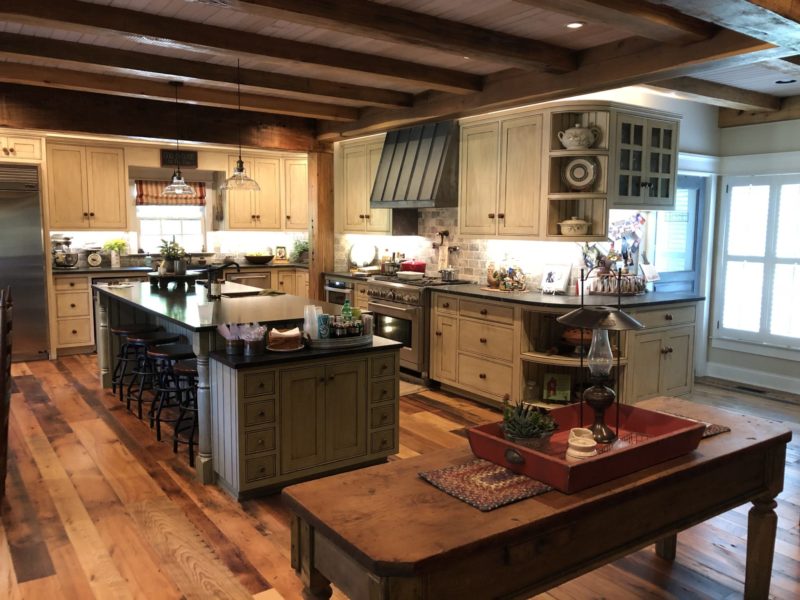Most people have a priority list of what is most important to them in their new home; however, budget usually wins out when the home is designed. However, you might not get another chance to redesign the bath room, add storage, make those steps wider, build a rock fireplace, etc. Now I realize that not all of our budgets are the same, but as my grandfather and mother always reminded me growing up, “buy the best you can afford, it cost less in the long run.” There are some aspects of a home that clients often don’t think about but that make a huge difference in the integrity and livability of their home.
With that in mind, let’s start with the dirt! First detail, A great foundation!
When is the last time your neighbor crossed the road just to compliment the size of your footers? Never! Well consider this, your timber or log home, finished could weigh in excess of a quarter million pounds! That’s like 3-4 tractor truck loads all parked on your foundation. Do you think the small footers most contractors put under a conventional house that weighs only a third of that will do a “great” job? I’ll leave that for you to ponder.
Most footers for timber homes and multistory homes should have a minimum of a 24” wide footer, 30-36” would be better, and never less than 18” thick continuously poured and reinforced with steel. The life of your entire house rest in the rigidity of this foundation. Don’t take short cuts!You don’t have time for them!
Second detail, the floor plan!
I’ve looked at thousands of blueprints, complied folders of little cabin ideas and restaurant napkins that had the best ideas ever on them! But the only ones that were really any good were the ones that “worked.” I mean, pictures are nice, cabinets are great but if you can’t maneuver or live in the home, then you might as well live in the lumber yard where your materials came from. A house is a living, animate, inspirational dwelling place with the potential to bring us together and help us be happy and refreshed. Or, it can be an absolute disaster when rooms are not grouped well, work rooms are on the wrong level, storage is not available or nonexistent, and so on the list goes! You see a little thought and a good eraser go a long way.
First, when beginning the design process, write out your spacial needs then group them. Next, prioritize the rooms by use. Then arrange them in your preliminary plan on the floor level you need them–don’t forget storage. Forget for now the confines of lot size, wall dimensions, and ceiling heights. Concern yourselves with the real issues. For instance, where are you going to iron clothes and will you want to pack clothes up three flights of stairs like a mule every time you do laundry. Take into account your age, in-laws and out-laws that might come visit or live with you, or God forbid an accident or illness that requires better access to major areas of the home. When you get this exercise down, your plan will start looking like a “working” home.
Doors are a must, but less might be more. Give yourself privacy and a good place to hide junk when uninvited family shows up. However, don’t chop your house into bits and make a corn maze out it. A plan that flows well will help as you build the overall design. Remember access with simplicity suits most of us better with our busy lifestyles than dividing our precious little space into 900 smaller ones. Good storage and well placed furniture will usually remedy the need for more room division.
When your working on your floor plan, keep in mind it is the floor plan that will be set in stone when your contractor is done unless you build in some “flexible”areas. For example, a loft that is a study today, can be an office tomorrow, a workout room on Tuesday and so on. A kitchen can double for an entertainment mecca and a quick dinning area. Basements have unlimited potential! The last thing you want to do is not have the ability to be flexible in a pinch, so use furniture to separate rooms and dimmers to set a mood. Use neutral colors that lend themselves to any environment and keep plugs and switches handy. My favorite area in our home is the kitchen. We entertain, have church potlucks, counsel friends, can produce with our kids and just unwind. It is where our family spends the most time together by far and has spawned many a great conversation. Some of that is due to the 100sq ft raised bar top island, some to the very accessible kitchen table that seats 6, some to the fully loaded pantry. However, when we designed our kitchen we thought about what kind of people that we are and our lifestyle. Our kitchen is designed the way it is because it reflects our lifestyles and personality. You have to match your rooms to your lifestyle and make it yours. Remember keep it open, keep it grouped and keep it flexible.
The third detail, maintenance! The log and timber industry’s dirtiest word!
Homeowners dread it and most procrastinate it. For the most part, they would really rather spend their hard earned money on the much more enjoyable elements of their home or outdoor living space. However, homeowners can design their homes to minimize the maintenance expense.
Start with the exterior facade: roof, windows and doors, etc. Generally speaking, the exterior walls and roof take the brunt of the weather. A roof is easily upgraded, so I usually put my wall finishes budget ahead of the roof. When building a log building, you should research what your kit dealer is providing and how your contractor applies the finish. You get what you pay for! Not all finishes are created equal and not all “good” finishes are good for your application. Pay great attention to the chinking on your cabin and the installer’s experience. Chinking is made to keep out water, not trap it in between the logs. No matter if it’s synthetic chink material over a ridged backer or an old lime based daubing in an old vintage cabin there is a proper way to install it and get the results that will give you years of trouble free service.
Timber frames are the ultimate “flex-house.” They can take on any style, any finish, and any floor plan. The best part is they can be built for hundreds of years worth of service with little or no maintenance. Exteriors of stone, brick, metal and some synthetic materials will give years of dependability and can be mixed, matched, and reinvented to give you the unique look you want. Conventionally built additions and surrounding structures can be treated with the same exterior facades to compliment your main home.
Maintenance doesn’t stop at the door, its all thru the house. Cost does not equal value! Most “high-end” lock sets are way over rated. I would rather have a good set of ball bearing hinges than a $300 lock that you can’t latch easily. Let your home talk to you. What will your eye fix on? That is where I would put my efforts! Comfort and reliability first, then name brand– buy American!
If you are really concerned with the long term maintenance of your structure and have a limited budget then consider shrinking your square footage and shift your money to what’s important to you.
Most details are forgotten when we are overwhelmed by the big decisions of the day, so try to slow down, concentrate, and plan. Try to coordinate with your contractor ahead of time and build a time line of when decisions will need to be made for layout, storage solutions, fixtures, appliances, finishes, etc. Good communication and an open dialog with your designer, builder, and the tradesmen will give you the greatest return on your investment. Good Luck!.


 The Process
The Process